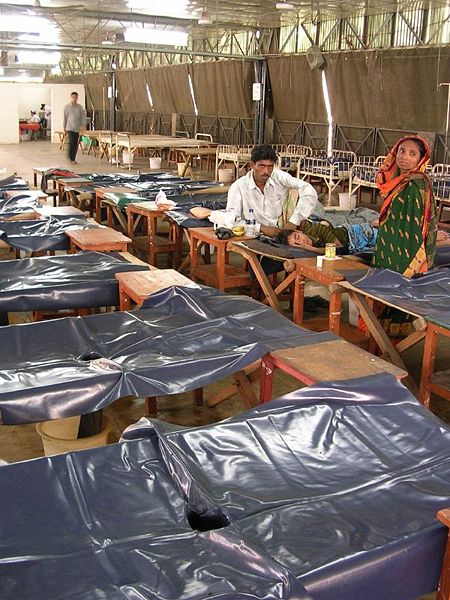Cholera primary prevention

|
Cholera Microchapters |
|
Diagnosis |
|---|
|
Treatment |
|
Case Studies |
|
Cholera primary prevention On the Web |
|
American Roentgen Ray Society Images of Cholera primary prevention |
|
Risk calculators and risk factors for Cholera primary prevention |
Editor-In-Chief: C. Michael Gibson, M.S., M.D. [1]; Associate Editors-In-Chief: Priyamvada Singh, MBBS [2]
Overview
Although cholera can be life-threatening, it is nearly always easily prevented, in principle, if proper sanitation practices are followed. In the United States and Western Europe, because of advanced water treatment and sanitation systems, cholera is no longer a major threat. The last major outbreak of cholera in the United States was in 1911. However, everyone, especially travelers, should be aware of how the disease is transmitted and what can be done to prevent it. Good sanitation practices, if instituted in time, are usually sufficient to stop an epidemic.
Primary prevention
Signals of an outbreak
- Increase number of acute diarrhoeal cases and patients having common symptoms-
- Watery diarrhoea, dehydration and vomiting
- Cases from same area or location
- Eaten the same food (for e.g. at a burial ceremony)
- Sharing the same water source
- Outbreak in the neighboring community
Steps in case of suspected cholera outbreak
- Inform and ask for help (supervisor, other centers)
- Treat patients promptly specially patients presenting as some or severe cholera symptoms (as they may deteriorate rapidly)
- Protect the community (prevent spread to others)
Checklist for medical professionals in case of suspected outbreak
In case of suspected cholera in community, medical professionals and hospitals should check the supplies to treat the patients.
- IV fluids (Ringer Lactate is the best, in case of nonavailability of ringer lactate cholera saline or normal saline can be used)
- Oral Rehydration Salt (ORS)
- Antibiotics (doxycycline, erythromycin, tetracycline)
- Rectal swabs and transport medium (Cary Blair or TCBS) for stool samples
- Safe water is needed to rehydrate patients and to wash clothes and instruments
- Chlorine or bleaching powder
- Nasogastric tubes
- Drips
- Soap
Steps to protect the community
There are several points along the transmission path at which the spread may be halted:
- Sickbed: Isolate the severe cases. Proper disposal and treatment of the germ infected fecal waste (and all clothing and bedding that come in contact with it) produced by cholera victims is of primary importance as stool and vomit are highly contagious
- Sewage: Treatment of general sewage before it enters the waterways or underground water supplies prevent possible undetected patients from spreading the disease.
- Sources: Warnings about cholera contamination posted around contaminated water sources through simple messages with directions on how to decontaminate the water.
- Sterilization: Boiling, filtering, and chlorination of water kill the bacteria produced by cholera patients and prevent infections, when they do occur, from spreading. All materials (clothing, bedding, etc.) that come in contact with cholera patients should be sterilized in hot water using (if possible) chlorine bleach. Hands, etc. that touch cholera patients or their clothing etc. should be thoroughly cleaned and sterilized. All water used for drinking, washing or cooking should be sterilized by boiling or chlorination in any area where cholera may be present. Water filtration, chlorination and boiling are by far the most effective means of halting transmission. Cloth filters, though very basic, have greatly reduced the occurrence of cholera when used in poor villages in Bangladesh that rely on untreated surface water. In general, public health education and good sanitation practices are the limiting factors in preventing transmission. Wash your hands with soap after using toilets and latrines, before preparing food, before eating
- Only eat freshly cooked food
- Do not defecate near the water sources
- Use latrines and keep them clean
Sari filtration
- An effective and relatively cheap method to prevent transmission of V. cholera is the practice of folding a sari (a long fabric garment) multiple times to create a simple filter for drinking water.[1]
- Folding saris four to eight times may create a simple filter to reduce the amount of active V. cholera in the filtered water.[2]
- The education of proper sari filter use is imperative, as there is a positive correlation between sari misuse and the incidence of childhood diarrhea; soiled saris worn by women are vectors of transmission of enteric pathogens to young children.[3] Educating at-risk populations about the proper use of the sari filter method may decrease V. cholera-associated disease.
Precautions for funerals
- Disinfect corpses with chlorine solution (2%)
- Fill mouth and anus with cotton wool soaked with chlorine solution
- Wash hands with soap after touching the corpse
- Disinfect the clothing and bedding of the deceased by stirring them in boiling water or by drying them thoroughly in the sun
References
- ↑ Ali M, Emch M, Yunus M, Sack D, Lopez AL, Holmgren J, Clemens J (2008). "Vaccine Protection of Bangladeshi infants and young children against cholera: implications for vaccine deployment and person-to-person transmission". Pediatr Infect Dis J. 27 (1): 33–7. doi:10.1097/INF.0b013e318149dffd. PMID 18162935. Unknown parameter
|month=ignored (help) - ↑ Z. Bhutta. Background Paper on the Integration of Oral Cholera Vaccines into Global Cholera Control Programmes. To be presented to the WHO SAGE in October 2009
- ↑ Stanton BF, Clemens JD, Clements JD (1986). "Soiled saris: a vector of disease transmission?". Trans R Soc Trop Med Hyg. 80 (3): 485–8. PMID 3798547.